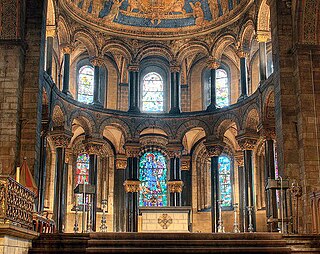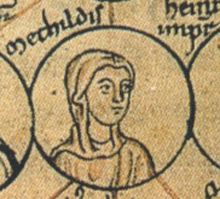
North Rhine-Westphalia or North-Rhine/Westphalia, commonly shortened to NRW, is a state (Bundesland) in Western Germany. With more than 18 million inhabitants, it is the most populous state in Germany. Apart from the city-states, it is also the most densely populated state in Germany. Covering an area of 34,084 km2 (13,160 sq mi), it is the fourth-largest German state by size.

Richeza of Lotharingia was a member of the Ezzonen dynasty who became queen of Poland as the wife of Mieszko II Lambert. Her Polish marriage was arranged to strengthen the ties between Mieszko and her uncle Emperor Otto III. She returned to Germany following the deposition of her husband in 1031, either divorcing or separating from him. Upon the death of her brother Duke Otto II of Swabia and the consequent extinction of the male line of her family, Richeza became a nun, worked to preserve the Ezzonen heritage, and funded the restoration of the Abbey of Brauweiler. She has been beatified.

Stavelot is a town and municipality of Wallonia located in the province of Liège, Belgium.
Hochsauerlandkreis is a Kreis (district) in the east of North Rhine-Westphalia, Germany. Neighboring districts are Soest, Paderborn, Höxter, Waldeck-Frankenberg, Siegen-Wittgenstein, Olpe, Märkischer Kreis.

Anno II was Archbishop of Cologne from 1056 until his death. From 1063 to 1065 he acted as regent of the Holy Roman Empire for the minor Emperor Henry IV. Anno is venerated as a saint of the Catholic Church.

Mosan art is a regional style of art from the valley of the Meuse in present-day Belgium, the Netherlands, and Germany. Although in a broader sense the term applies to art from this region from all periods, it generally refers to Romanesque art, with Mosan Romanesque architecture, stone carving, metalwork, enamelling and manuscript illumination reaching a high level of development during the 11th, 12th and 13th centuries.

Brauweiler Abbey is a former Benedictine monastery located at Brauweiler, now in Pulheim near Cologne, North Rhine-Westphalia, in Germany. It is now used as a regional cultural center.

Kaiserswerth is one of the oldest quarters of the City of Düsseldorf, part of Borough 5. It is in the north of the city and next to the river Rhine. It houses the Kaiserwerth Deaconesses' Institute where Florence Nightingale worked. Kaiserswerth has an area of 4.80 km2 (1.85 sq mi), and 7,923 inhabitants (2020).

Michaelsberg Abbey is a former monastery of the Benedictine Order, belonging to the Subiaco Congregation (1064-2011). The monastery is situated on the Michaelsberg, about 40 metres above the town of Siegburg. For this reason it is also often known as Siegburg Abbey.

The Duchy of Westphalia was a historic territory in the Holy Roman Empire, which existed from 1102 to 1803. It was located in the greater region of Westphalia, originally one of the three main regions in the German stem duchy of Saxony and today part of the state of North Rhine-Westphalia. The duchy was held by the archbishop-electors of Cologne until its secularization in 1803.

Kamp Abbey, also known as Altenkamp Abbey or Alt(en)feld Abbey was the first Cistercian monastery founded in German territory, in the present town of Kamp-Lintfort in North Rhine-Westphalia.

The Great Saint Martin Church is a Romanesque Catholic church in Cologne, Germany. Its foundations rest on remnants of a Roman chapel, built on what was then an island in the Rhine. The church was later transformed into a Benedictine monastery. The current buildings, including a soaring crossing tower that is a landmark of Cologne's Old Town, were erected between 1150-1250. The architecture of its eastern end forms a triconch or trefoil plan, consisting of three apses around the crossing, similar to that at St. Maria im Kapitol. The church was badly damaged in World War II; restoration work was completed in 1985.

The Golden Madonna of Essen is a sculpture of the Virgin Mary and the infant Jesus. It is a wooden core covered with sheets of thin gold leaf. The piece is part of the treasury of Essen Cathedral, formerly the church of Essen Abbey, in North Rhine-Westphalia, Germany, and is kept on display at the cathedral.

The Cologne borough of Deutz is a part of central Cologne, Germany, and was once an independent town.

Herford Abbey was the oldest women's religious house in the Duchy of Saxony. It was founded as a house of secular canonesses in 789, initially in Müdehorst by a nobleman called Waltger, who moved it in about 800 onto the lands of his estate Herivurth which stood at the crossing of a number of important roads and fords over the Aa and the Werre. The present city of Herford grew up on this site around the abbey.

Prince-provost is a rare title for a monastic superior with the ecclesiastical style of provost who is also a Prince of the Holy Roman Empire (Reichsfürst), holding a direct vote in the Imperial Diet assembly coequal to an actual Prince-abbot, as in each case treated below.

Rudolf Amelunxen was a German politician of the Zentrum and the 1st Minister President of North Rhine-Westphalia between 23 August 1946 and 17 June 1947. He was born in Cologne and died on 21 April 1969 in Grafschaft Abbey, North Rhine-Westphalia.

Beatrice I, also known as Beatrice of Franconia, was Abbess of Gandersheim Abbey from 1043 and Princess-Abbess of Quedlinburg Abbey from 1044 until her death.

Matilda, Countess Palatine of Lotharingia, was a member of the Ottonian dynasty.
Minnborinus of Cologne was an Irish abbot and saint active in Germany.


















